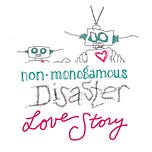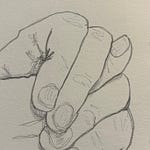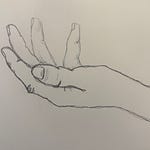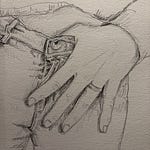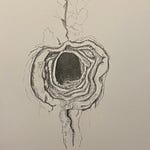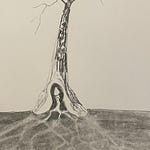A few weeks ago, I was riding with Whyla as she drove with her teenage son (for convenience’s sake, I’ll refer to him as Ted Whylason). We were on the way to pick up a friend of his; she was driving them to the White Mountains, where the boys were to do an ambitious, all-day run. After the friend got settled, I introduced myself to him, as is only proper. For a nanosecond and with a neutrino of panic, I wondered, exactly how do I identify myself? Who was I? What was I doing there in the car? What is that beautiful house? Where does that highway go to? I supposed that some relational statement was in order. “I’m Ted Whylason’s mom’s boyfriend, in a polyamorous arrangement between Whyla and me, with the consent of Whyla’s husband, Witt. Ted [whom I’ll also refer to as Ted Wittson] knows about this and he’s ok with it, too. We’re riding in a car, not a nuclear missile.”
I decided against this. It would have been a mouthful. Plus, speaking of relations, I was in the front seat and the friend was in the back, and my neck already hurt. So I instead I said, “I’m Steve.” I figured, my name is ID enough, at least, for an introduction to someone. I easily and simply attach myself to it, as a statement of self-standing independence, as we each do with our names, although they’re assigned to us by our parents, though at age five I insisted to my mother that I be known as Steve, which at the time she assented to with outward gravitas and inward bemusement, waiting me out until I reconciled myself to my birth name, which is not Steve, which for anonymity’s sake I now again choose as my name. #irony
I didn’t identify myself to Ted W. Wittson’s friend by my relation to Whyla or to anything else. The friend would have to form an impression of me in some other way, in a context particular to him and how I related to him, which was mainly that I was polite, cooked food, and loaned him and Ted my Theragun, a sophisticated percussive massage device coveted by hard-charging athletes like those two.
Identifying simply by one’s name seems both minimal and expansive. A name is a kind of place-holder for the person, for the individual, for the self. Thinking of oneself and presenting oneself by one’s name doesn’t cast oneself in a category or a type, or a function or relation. In itself, such an ID doesn’t reveal much, but it also doesn’t box one in. Perhaps it gets at the deep truth of being human more than…well, being a thing or being a way. Being seems to imply fixity, permanence, situation — especially a situation of being stuck in the amber of common nouns — and seems to obscure that each of us is an individual, and can act, change, choose. None of these things with perfect simplicity, of course — we are thrown into this life, set with wings and weights we didn’t make, and we exist among others, wanting to know and be known, to have security and rest, existentially, psychically. And justice is a natural concern. Defending oneself against the powerful; ameliorating large and pervasive wrongs in society — these require collective action, presenting a common cause, asserting oneself as part of a group. So the inclination to identify oneself with a category, a type, a greater something — not to present oneself simply as an individual — can’t be fully or fairly avoided. Still, it seems that keeping one’s ID restrained, and averting an over-nominalization of oneself (and life) — leaves room for more personal experiences and interpersonal exchanges, enabling them to have whatever form best fits them. To do and have more, to know oneself and get to know others better, identify less.
Or go negative! Whyla considers herself non-monogamous (that is, as a description of the situation she has chosen). A stylish stylist, she regards the trendy term “polyamorous” with a mixture of scorn and bemusement (in a 9:1 ratio). She would never identify herself that way — it’s absurd to identify a person with a relationship structure, with something outside oneself that is actually quite contingent (Could one reasonably be polyamorous while actually single, alone on the proverbial desert island?). Plus, if an identity is meant to distinguish, then “polyamory” fails, since most people have multiple loving, intimate relationships with several others (parents, children, friends) at the same time, with no special ID. And, on the timeline of a lifetime, consider that each person typically has multiples of romantic partners, no matter when in the continuum “the one” comes along. No swans among us (and even bereaved swans move on to others). If monogamy, as a relationship structure and an idea, means attachment to “my one and only” — exclusivity in feelings, attention, time shared, emotional support, sexual desire, imagination, expression — maybe most of us are non-monogamous. Perhaps nothing more as well as nothing less — non-monogamous rather than polyamorous. To keep identification minimal (though the minimum is also fundamental), one could describe oneself, acknowledge in oneself, excitability, curiosity about who’s out there, and how it might feel in their company. And then, introspection with oneself, discussion and deliberation with current or potential relationship partners about what, if anything, to do about that excited curiosity. The result, unlike an identity, may vary across time and persons. Some people, in some situations, may actually end up in a polyamorous arrangement.
Like Whyla! For all the gustatory revolt that that term provokes in her, she does polyamory very, very well! This is true not only in the ordinary aspect noted above — she loves her family and friends, to whom she gives generously of her time and attention. Whyla also loves in the romantic, erotic, ineffably special way that constitutes, to a simple-minded etymologist like me (Whyla being the entymologist), the “amory.” She does for me, talks with me, writes to me, listens to me, leans on me, shares with me, cares for me, sexes it up with me, makes me feel good to be me — she makes me feel loved, amply and uniquely. And she does the same for Witt. If anyone could describe herself as polyamorous (or at least duamorous — biamorous — ambiamorous?), it is she. Extending herself and opening herself as she does requires an extraordinary degree of self-inquiry, self-knowledge, self-acceptance, and the trust and confidence to bring herself to me. Curiosity, communication, care — she’s shows how these are the soil for each of her love relationships, and so for both. Not that her balancing act is easy. Time and attention are always finite, always scarce resources, and she needs to distribute them to herself too, in this triad. It’s tough. It takes skill.
As the mayor of Blithedale, I thought I was polyamorous by the time Whyla and I met. I supposed that polyamory was easy, and put myself in that category. I had met with success in dating and various hookups with acquaintances, which, by that stage of my life, addled me - after decades-long sexual deprivation, insecurity about my attractiveness, and failed relationships, it felt a furlough from prison to the carnival. The era of app-enabled photo-and-text-based connections was fortunate for an insecure introvert who was seeking physical and psychic fulfillment of some kind. Conditions looked favorable for this new era to keep on rolling. I thought that my presentation, my mode — charming in flirtation, pleasant, and agreeable in conversation, technically proficient and in control in sex — was sufficient. I identified myself with those aspects, because it seemed enough for me to be liked, enough to enable sexual adventures, enough to meet my urges and inclinations.
But as I romped I didn’t pause for introspection, questions, curiosity, counsel from friends. These might have exposed some deep cracks in me, in my sense of worth, in my ability to be still, in my capacity to be present and really present myself to the women I was engaging with. Pauses would also have exposed barriers to recognizing each woman as herself, and not by stereotypes I imposed on them by sexism or by notions I imposed on myself about chivalry and relations between the sexes. And still buried in me was the longstanding belief that my libido was shameful and base, my interest in variety frivolous, and my uncertainty and inexperience about intimacy and commitment, contemptible. To allay this anxiety and distress, to be publicly acceptable, follow the strict orders - present boyfriend and serious romantic relationship right away. Or else. Or else what, I didn’t pause to consider.
Driven by haste against healthy doubt, stillness, curiosity — enabled by the apps’ handiness and parade of hotties — dressed in my charming costume — drunk with the idea that women I was attracted to found me attractive — propped up by the notion that in these liberated times, concurrent love affairs in broad daylight were an acceptable and even chic lifestyle — I engaged woman after woman, starting friendly and fun, though inevitably imposing the bizarre bloated boyfriend experience that was Steve.
I acted as if relationships were easy and free — free of awkward, difficult, emotional discussions about how much connection and how much freedom I wanted, how much of myself I was willing and eager to share, free of having to address the inevitable question about distribution of time and attention, free of the hard work of being candid about the presence and care I could and could not provide. These things are a challenge to attend to with any two persons. They require self-knowledge and trust, and an ethos of honesty, acceptance, commitment, mindfulness. In my state of severe emotional arrested development at the time, I was incapable. Sanity, sense, sobriety, had I had or would have heeded any of them, counseled a verrrry slow procession in getting to know others, personally and, especially, carnally. In truth, I should have turned inward, staying there until I was ready to turn outward, to be present with myself and to be intimate with anyone, and certainly before trying to be intimate with anyones.
As for what I actually did in my frenzy, I got emotionally and sexually involved with three women successively and concurrently — the woman I’d been dating since the previous summer, Whyla whom I met in the fall, and, later, a third woman I met in the winter — and I had a hookup with yet another woman who, though quite into me physically, was altogether uninterested in boyfriend Steve [a fact that Whyla routinely pointed out], though that didn’t keep my inner script from ordering me to offer the deal, or else I’d be a cad. This state of affairs at times resembled an Elvis Presley comedy, if Elvis had been emotionally spastic, burned the sets down, and drove himself and his three paramours speeding off a cliff.
I thought I was polyamorous, a virtuoso of love, like one of those vaudeville entertainers spinning plates on poles, one after another after another. However, truth, as ever, is fundamental, and, for me, lands, as usual, like that thing that hit Earth and made the moon. In truth, I was hidden, to myself and others, fearful of intimacy, on guard against knowing and being known, loving and being loved. I was polyarmorous. Now there’s an identity!
Maybe if I had identified that way, the psychological rigor of identification might have restrained me from relationships, and thus spared several people some serious grief. But, however tumultuous the experiences and however great my sense of guilt, I have been trying to grow and learn by it all. And if I had such a hermetic past, I wouldn’t have met Whyla! Nor would I have, through her patience, wisdom, openness, support, forbearance, forgiveness, been able to learn how to accept and be accepted, to love and be loved. And that includes me toward myself. Maybe I am polyamorous after all.

